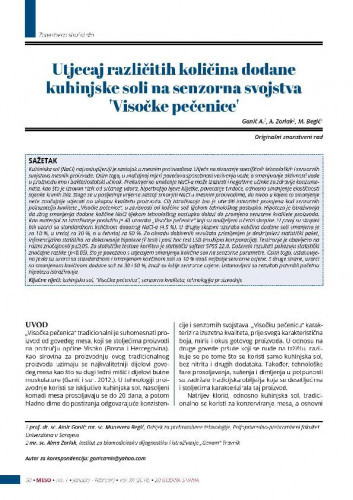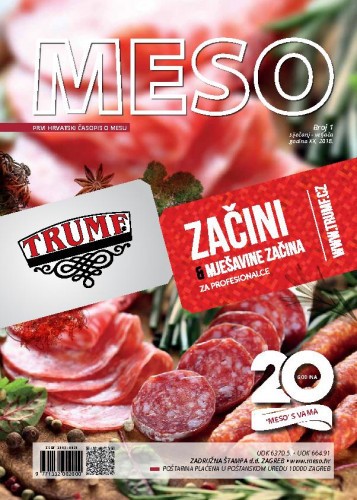Kuhinjska sol (NaCl) najzastupljeniji je sastojak u mesnim proizvodima. Utječe na stvaranje specifičnih tehnoloških i senzornih svojstava mesnih proizvoda. Osim toga, u značajnoj mjeri povećava sposobnost vezivanja vode, a smanjivanje aktivnosti vode u proizvodu ima i bakteriostatski učinak. Prekomjerno unošenje NaCl-a može izazvati i negativne učinke za zdravlje konzumenata, kao što je izravan rizik od srčanog udara, hipertrofija lijeve klijetke, povećanje tvrdoće, odnosno smanjenje elastičnosti stjenke krvnih žila. Stoga se u posljednje vrijeme nastoji smanjiti NaCl u mesnim proizvodima, do nivoa u kojem to smanjenje neće značajnije utjecati na ukupnu kvalitetu proizvoda. Cilj istraživanja bio je utvrditi intenzitet promjena kod senzornih pokazatelja kvalitete „Visočke pečenice“, u zavisnosti od količine soli tijekom tehnološkog postupka. Hipoteza je istraživanja da zbog smanjenja dodane količine NaCl tijekom tehnološkog postupka dolazi do promjena senzorne kvalitete proizvoda. Kao materijal za istraživanje poslužilo je 40 uzoraka „Visočke pečenice“ koji su podijeljeni u četiri skupine. U prvoj su skupini bili uzorci sa standardnom količinom dodanog NaCl-a (4,5 %). U drugoj skupini uzoraka količina dodane soli smanjena je za 10 %, u trećoj za 30 %, a u četvrtoj za 50 %. Za obradu dobivenih rezultata primijenjen je deskriptivni statistički paket, inferencijalna statistika za dokazivanje hipoteze (F test) i post hoc test LSD (multipla komparacija). Testiranje je obavljeno na razini značajnosti p≤0,05. Za statističke testove korišten je statistički softver SPSS 22.0. Dobiveni rezultati pokazuju statistički značajne razlike (p<0,05), što je povezano s utjecajem smanjenja količine soli na senzorne parametre. Osim toga, ustanovljeno je da su uzorci sa standardnom i smanjenom količinom soli za 10 % imali najbolje senzorne ocjene.; The influence of different quantities of the added NaCl on the sensory properties of “Visočka pečenica” Common salt (NaCl) is the prevalent ingredient of meat products. It affects the formation of some specific technological and sensory properties of meat products. Besides, it significantly increases the water bonding capacity whereas the reduction of water activity in the product has a bacteriostatic effect. Except for the positive effect, the excessive intake of NaCl can cause some negative effects on the consumer’s health, such as direct risk of a heart attack, hypertrophy of the left heart chamber, hardening and decreased elasticity of blood vessels, etc. Therefore, there has been an intention recently to reduce the quantity of NaCl in meat products to the level at which the reduction will not affect the general quality of the product in a negative way and to a great extent. The aim of the research is to determine the intensity of changes with sensory indicators of the quality of “Visočka pečenica”, depending on the salt quantity during the technological procedure. The hypothesis of the research is that there will be changes of the sensory quality of the product due to the reduction of the added quantity of NaCl during the technological procedure. As the research material twenty samples of „Visočka pečenica“, divided into four groups. The first group comprised samples with a standard quantity of the added NaCl (4,5 %). In the second group the quantity of the added salt was reduced by 10 %, in the third group it was reduced by 30%, and in the fourth group it was reduced by 50 %. While processing the obtained results we applied a descriptive statistical package, the interferential statistics for proving the hypothesis (F test) and the post hoc test LSD (multiple comparison). The testing was done at the significance level p≤0,05. Statictical tests were done by using statistics software SPSS 22.0.; Auswirkung der Zugabe unterschiedlicher Mengen von NaCl auf die sensorischen Eigenschaften der Bratwurst “Visočka pečenica” Speisesalz (Na Cl) ist die häufigste Zutat in Fleischprodukten. Es wirkt sich auf spezifische technologische und sensorische Eigenschaften von Fleischprodukten aus. Darüber hinaus steigert es die Fähigkeit zur Bindung von Wasser und infolge der Senkung der Wasseraktivität im Produkt verfügt es außerdem über eine bakteriostatische Auswirkung. Außer den positiven Auswirkungen kann eine übertriebene Zufuhr von Na Cl auch negative Auswirkungen auf die Gesundheit der Verbraucher haben, die sich im unmittelbarem Risiko eines Herzinfarkts, der Linksherzhypertrophie, der Reduktion der Elastizität der Gefäßwände, bzw. deren Versteifung widerspiegeln. Daher wird in der letzten Zeit der Gehalt von Na Cl in Fleischprodukten bis zum Gehalt reduziert, welcher die Qualität des Produktes insgesamt nicht beeinträchtigt. Das Ziel dieser Untersuchung bestand darin, die Intensität der Veränderungen bei den sensorischen Qualitätsmerkmalen der Bratwurst „Visočka pečenica“ in Abhängigkeit vom Salzgehalt während des technologischen Verfahrens festzulegen. Die Untersuchung ging von der Hypothese aus, dass es infolge der Reduktion der Zugabe von NaCl während des technologischen Verfahrens zur Veränderung der sensorischen Produktqualität kommt. Als Untersuchungsmaterial dienten 40 Proben der Bratwurst „Visočka pečenica“, welche in vier Gruppen eingeteilt wurden. Die erste Gruppe bestand aus Proben mit einem üblichen NaCl-Gehalt (4,5 %). In der zweiten Gruppe wurde die Menge des beigefügten Salzes um 10%, in der dritten Gruppe um 30% und in der vierten Gruppe um 50% reduziert. Für die Bearbeitung der gewonnenen Ergebnisse wurden das deskriptive Statistikpaket, die inferentielle Statistik zum Nachweis der Hypothese (F-Test) und der Post-hoc-Test LSD (Mehrfachvergleich) herangezogen.
Sažetak

 Meso : prvi hrvatski časopis o mesu : 20,1(2018) / glavna i odgovorna urednica, editor-in-chief Katarina Lučić.
Meso : prvi hrvatski časopis o mesu : 20,1(2018) / glavna i odgovorna urednica, editor-in-chief Katarina Lučić.